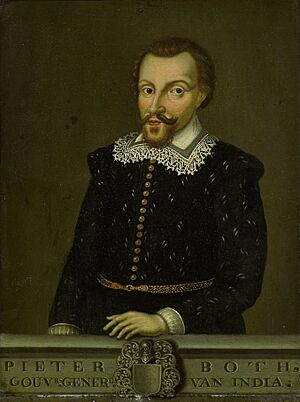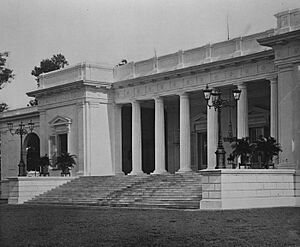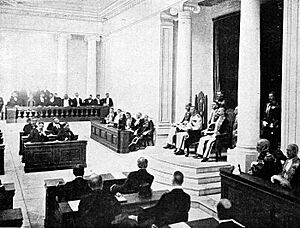Governor-general of the Dutch East Indies facts for kids
Quick facts for kids Governor-General of the Dutch East Indies |
|
|---|---|

Coat of arms of the Dutch East Indies
|
|
| Residence |
|
| Seat | Batavia |
| Appointer |
|
| Formation | 19 December 1610 |
| First holder | Pieter Both |
| Final holder | Tony Lovink |
| Abolished | 27 December 1949 |
| Succession | President of Indonesia |
The Governor-General of the Dutch East Indies was the most important leader in the Dutch East Indies. This was a large area in Southeast Asia, which is now Indonesia. The Governor-General represented the Dutch government there. This role existed from 1610 until 1949, when Indonesia became an independent country.
Contents
A Look at History
Early Leaders: The VOC Era
The first Governors-General were chosen by a powerful trading company. This company was called the Dutch East India Company (VOC). The VOC was a huge company that traded spices and other goods. It also controlled many lands in Asia.
In 1800, the VOC was officially closed down. The Dutch government then took over all the lands the company owned. These lands became a colony of the Netherlands. It was called the Dutch East Indies. After this, the Dutch king or government chose the Governors-General.
Changes Over Time
Most Governors-General during the VOC era settled in the East Indies. They often lived there for good. But later, during the Dutch East Indies era, most Governors-General were Dutch people. They came from the Netherlands to work in the colony.
For a short time, from 1811 to 1816, the British took control of the Dutch East Indies. During this time, the top leader was called a lieutenant-governor. A famous one was Thomas Stamford Raffles.
Later, from 1942 to 1945, Japan controlled the area during World War II. Even though there was a Dutch Governor-General named Hubertus Johannes van Mook, the real power was with the Japanese governors. After 1948, as Indonesia moved towards independence, the top Dutch leader was called the high commissioner of the crown.
The Governor-General's Role
The Governor-General was the highest Dutch authority in the Dutch East Indies. They were like the chief executive of the colony. They led the colonial government and were also the commander of the colonial army. Until 1903, all government workers and groups reported to the Governor-General. Their money also came from the Governor-General's office.
The Governor-General represented the Dutch Empire and the Dutch king or queen. They had a lot of power in the colony. Before 1815, they could even ban or control any newspaper or book. They also had "exorbitant powers." This meant they could send anyone away from the colony if they thought they were dangerous. They could do this without a court trial.
Until 1848, the Dutch king or queen directly chose the Governor-General. Later, the Dutch government helped advise the king or queen on who to pick. For some periods, the Governor-General worked with an advisory group. This group was called the Raad van Indie (Indies Council). Together, they were known as the "high government."
Overall, the main plans for the colony came from the Ministry of Colonies. This ministry was in The Hague, Netherlands. Often, a former Governor-General would lead this ministry.
Steps Towards Self-Rule
In the 20th century, the colony slowly started to become more separate from the Netherlands. For example, its money system became independent in 1903. The colony also started taking out its own loans from 1913. It even started having some diplomatic talks with countries like Saudi Arabia. This was to help manage the Haji pilgrimage for people from the Dutch East Indies.
In 1922, the Dutch constitution said the colony was equal to the Netherlands. But it still remained under the Ministry of Colonies.
Some Governors-General believed in a policy called the "ethical policy." This policy aimed to improve the lives of the local people. Because of this, a council for the Dutch East Indies was created in 1918. It was called the Volksraad (People's Council).
The Volksraad was an early form of a democratic council. But it could only give advice. Also, only a small number of people could vote for its members. The council had 30 local members, 25 European members, and 5 members from Chinese and other groups. A new council was chosen every four years. In 1925, the Volksraad gained more power. The Governor-General was then expected to ask the Volksraad for advice on important matters.
See also
- List of governors of the Dutch East Indies




